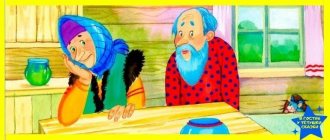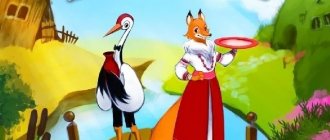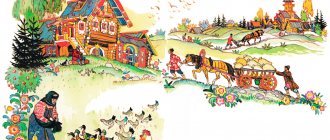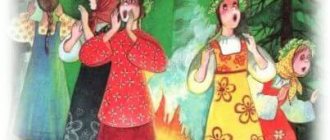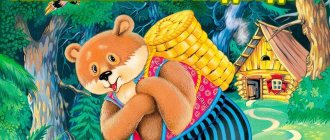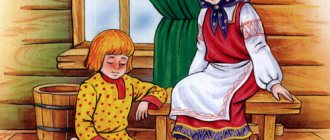Lesson summary Game-drama based on the fairy tale “Turnip”
Lesson summary
Game-drama based on the fairy tale “Turnip”
Kotelnikova I.E., teacher
Goals and objectives:
Arouse interest in the fairy tale “Turnip”. Learn to play the role of a fairy tale character with the help of an adult. Reinforce knowledge about yellow and green colors. Continue teaching children to draw with crayons. Develop in children the ability to listen carefully. Develop attention, speech, sense of rhythm, fine motor skills, coordination of movements. Continue to develop the pronunciation of vowel sounds through onomatopoeia (“meow-meow”, “woof-woof”). Cultivate friendly relationships with peers.
Material and equipment:
Decorations for the theater.
Attributes for staging a fairy tale: hat, scarf, apron, “Dog”, “Cat”, “Mouse” hats.
colored pencils (wax crayons) green and yellow.
Blank coloring pictures “Turnip”. Preliminary work:
reading the Russian folk tale “Turnip”, looking at illustrations for the fairy tale. Progress of activities
Hello my good guys. Today we will go to
fairy tale and it is called “Turnip”. This is a Russian folk tale.
The teacher shows the children a presentation with pictures based on the fairy tale “Turnip”.
Educator:
There is a turn in the village, next to a private vegetable garden, a yard and a small house - an old man and his family live here. You and I were there - what kind of family was this?
(children's answers) So as not to bother us, we'll tell you who does what. A dramatization of the fairy tale “Turnip”
Children put on attributes (hat, scarf, apron, “Dog”, “Cat”, “Mouse” hats). Then the children perform their role to the words of the fairy tale that the teacher tells.
Educator: Grandfather planted a turnip.
A boy (grandfather) comes out, plants and waters the turnip. Educator: The turnip has grown big, very big. Grandfather began to pull the turnip out of the ground: he pulled, he pulled, but he couldn’t pull it out. Grandfather called Grandma to help.
A girl (grandmother) comes out and helps her grandfather. Educator: Grandma for Dedka, Grandfather for the turnip: they pull, they pull, they can’t pull. Grandmother called her Granddaughter.
A girl (granddaughter) comes out and helps her grandfather and woman.
Educator: Granddaughter for Grandma, Grandmother for Grandfather, Grandfather for the turnip: they pull, they pull, but they can’t pull. The granddaughter called Zhuchka.
The boy (bug) comes out and helps the others.
Educator: Bug for Granddaughter, Granddaughter for Grandmother, Grandmother for Grandfather, Grandfather for the turnip: they pull and pull, but they can’t pull. She called the Bug Cat.
The girl (cat) comes out and helps the others.
Educator: Cat for the Bug, Bug for the Granddaughter, Granddaughter for the Grandmother, Grandmother for the Grandfather, Grandfather for the turnip: they pull, they pull, they can’t pull. The Cat called the Mouse. A girl (mouse) comes out and everyone starts pulling.
Educator: Mouse for Cat, Cat for Bug, Bug for Granddaughter, Granddaughter for Grandmother, Grandmother for Grandfather, Grandfather for the turnip: pull - pull - pull the turnip.
Educator: Well done, guys. You helped the fairy tale come to life, you told it expressively, you showed it.
Drawing with crayons
“Turnip”
Educator: Now let’s color the turnip in the picture.
What color of chalk will we take to decorate the turnip?
Yellow chalk. What color should we paint the leaves and tops with? Green.
Educator: We hold a pencil in our right hand, and hold a piece of paper with our left. We hold the pencil with three fingers, pinch it with the thumb and forefinger and hold it with the middle one. We paint the turnip without going beyond the contours, with large and small strokes.
After finishing, the teacher collects all the drawings together.
Summing up (conclusion)
Educator: Look what turnips we got: beautiful, juicy.
And what else? (children's answers: yellow, round.)
Educator: Well done.
Annex 1
Presentation "Tale Turnip"
Master class “Stages of working on the fairy tale “Turnip” in speech practice lessons
Master class “Stages of working on the fairy tale “Turnip” during speech practice lessons in the preparatory class”
Purpose: To acquaint teachers with experience in using fairy tales for the cognitive development of students.
Objectives: • expand teachers’ knowledge about fairy tales as a means of cognitive development for students
• enrich the intellectual, cognitive, moral and aesthetic experience of colleagues, allowing them to improve themselves in working with children
• introduce the stages, form and methods of working with children using the plot of a fairy tale.
Equipment: multimedia projector, interactive whiteboard, handouts
Progress of the master class.
Introductory part.
Good afternoon, dear colleagues! I would like to start my master class with a small quatrain:
“And we can’t live without a fairy tale, friends
After all, with a fairy tale it is easier to believe in miracles.
After all, with a fairy tale it is easier for us to find the way.
Into a small heart, open the door.”
Presentation of teaching experience.
The issue I consider in this master class - teaching children through fairy tales - is, in my opinion, interesting and relevant. The child feels the secret contained in the fairy tale. A fairy tale serves as a bridge connecting the outside world with the inner world of a child. A fairy tale is an indispensable tool for shaping a child’s personality. Fairy tales contribute to the development of creative thinking and imagination in a child. With the help of a fairy tale, you can introduce your child to the world around him in a fun way, help him better understand and understand it. With its help, you can revive the material being studied. When a child listens to a fascinating story, he experiences it together with the characters, while solving complex intellectual problems, reasoning, and logically justifying his actions. Using fairy tales in my work with students, I observe a positive impact on faster and more durable learning. Children's cognitive activity increases and their interest in learning becomes more active.
Like any other fairy tale, “Turnip” certainly has its own meaning, its own tasks. It teaches children that family and friends are a huge support in life and therefore need to be valued and protected.
When working on a fairy tale, I use the following stages , forms and methods of work:
First stage.
Introduction to the fairy tale.
I slowly tell the fairy tale “Turnip”, accompanying the story with a demonstration of pictures on the interactive board.
Having finished telling the story, I propose to show how they pulled the turnip, while saying “Pull-pull, pull-pull - they pulled the turnip!”
“The turnip was very big,” I remind you and ask you to show the size of the turnip.
We tell how they pulled the turnip: “The mouse is behind... (showing the cat)?” - “Cats for? ..."; “Granddaughter for it? ..."; “Grandma for?...”; “Grandfather for?...”
-Reading fairy tales (is the main form of getting to know any fairy tale).
— Watching a cartoon
— Retelling, you can use mnemonic tables
In which, at stage 1, we look at the table and analyze those who are drawn in it. At stage 2, we recode the information. At stage 3, we retell the fairy tale based on symbols. In this case, the retelling can be carried out by the children themselves, with a little help from an adult.
Second phase .
Educational and didactic games based on the content of the fairy tale
.
• I develop in children the ability to complete tasks in accordance with the plot of a fairy tale (build series of logical chains of characters on an interactive board)
• I encourage children to work in pairs, small groups, teams (the “microphone” game, where one student tells another about some part of the fairy tale, and the second checks)
• I activate children’s creative abilities and coherent speech through developmental and intellectual tasks
«What would happen if..."
Description: I invite the children to come up with and continue a sentence, for example: What would have happened if the mouse had not come to the rescue?
“The artist’s mistake” where I ask the children to look carefully at the drawing and say whether the artist drew everything correctly
True False.
Target. Consolidating knowledge of fairy tales, developing coherent speech, and the ability to listen carefully to each other.
Description. I read the sentence, and the children must agree or disagree. For example: Grandfather by the turnip, granddaughter by grandfather, they pull, pull, but cannot pull. The granddaughter called the mouse.
“Complete the character.” I hand out pieces of paper with circles to the children; their task is to draw an element to the circle so that it becomes clear who or what it is.
“Find the outline of the turnip”
Fairy tale and mathematics.
When working on the fairy tale “Turnip”, the interdisciplinary connection between speech practice and mathematics is clearly visible.
What was the turnip like when your grandfather planted it? What was she like when she grew up? What kind of figure does she look like? With your child, find objects similar to a turnip in shape, size, color.
In every fairy tale you can count something: When the grandfather came, what was his counting number? (first) Babka (second), etc. - this is a good training not only for mathematical skills, but also for the development of speech (first, second, third).
Repeated repetition of characters, sizes (medium, smallest) - develops memory, attention, hearing.
Thus, with the help of a fairy tale plot, you clarify the sequence of numbers, serial numbers, and learn to distinguish objects by size
Remember who was the first to pull the turnip, who was the last, who stands between grandfather and granddaughter; this simple exercise will help teach your child the correct use of prepositions, especially if you highlight them with your voice.
The third stage
“Drawing a fairy tale”
- Creative tasks. Drawing, modeling, applique of fairy-tale characters from available materials.
• You can use modeling of fairy tale plots.
Fourth stage
“Theatrical games”
Forming the speech activity of students. I give an idea of the variety of expressive means of theatrical activity. After studying and consolidating the fairy tale, I assign roles to the children, taking into account individual characteristics. I work on expressiveness, gestures, and facial expressions directly during the staging itself.
Result of the master class
The use of these methods and techniques contributes to the development of cognitive activity, the formation of creative personality traits in students; teaches the actions through which creativity is realized. Using fairy tales in my work with students, I observe a positive impact on faster and more durable learning. Children's cognitive activity increases and their interest in learning becomes more active. Organizing classes with educational fairy tales helps the child turn from a passive, inactive observer into an active participant.
Literature
1. Bolsheva T.V. “We learn from a fairy tale. A manual for kindergarten teachers." / S – Pb., “Childhood – press”, 2001.
2.Dyachenko O.M. “Methodology for the development of creative imagination, ed. Tkachenko, T.A. A large book of tasks and exercises for the development of a child’s coherent speech. A manual for kindergarten teachers" - M.: Eksmo, 2006.
3. Propp V.Ya. "Morphology of a fairy tale."
4. Sidorchuk T.A., Lelyukh S.V. “We explore the world and fantasize with Llull circles. A practical guide for classes with children aged 3-7 years.”
5. Fesyukova L.B. "Education with a fairy tale."
